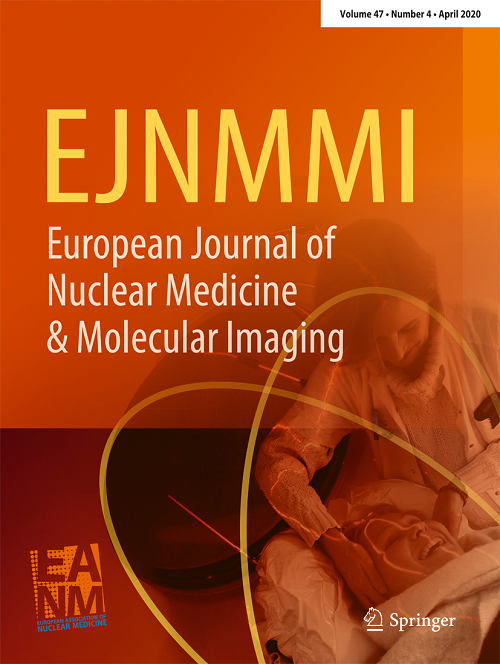18 F-PET-CT脑代谢成像和机器学习聚类分析显示肌萎缩侧索硬化症患者的代谢表型存在差异。
IF 7.6
1区 医学
Q1 RADIOLOGY, NUCLEAR MEDICINE & MEDICAL IMAGING
European Journal of Nuclear Medicine and Molecular Imaging
Pub Date : 2025-10-03
DOI:10.1007/s00259-025-07585-5
引用次数: 0
摘要
背景:肌萎缩性侧索硬化症(ALS)是一种致命的神经退行性疾病,具有显著的临床病理异质性。本研究旨在通过整合脑18f -氟脱氧葡萄糖正电子发射断层扫描-计算机断层扫描(18f - fdg PET-CT)代谢成像与一致的聚类数据来识别不同的ALS表型。方法前瞻性研究纳入127例ALS患者和128例健康对照。所有参与者都进行了脑18f - fdg - pet - ct代谢成像、心理问卷调查和功能筛查。采用k均值一致聚类来定义基于神经影像学的表型。还进行了生存分析。利用全外显子组测序(WES)检测als相关基因突变,然后利用18 F-FDG-PET-CT成像进行GO/KEGG通路富集和基于脑代谢活性的成像-转录组分析。结果根据葡萄糖代谢活动模式,聚类一致鉴定出代谢衰减型和代谢非衰减型两种代谢表型。代谢衰减表型与较差的生存(p = 0.022)、较差的身体功能(p = 0.005)、较严重的抑郁(p = 0.026)和较高的焦虑水平(p = 0.05)相关。WES测试和神经成像转录组分析确定了每种表型的特定基因突变和分子途径。我们发现了两种不同的ALS表型,它们具有不同的临床病理特征,这表明应用于PET成像的无监督机器学习可以有效地分类ALS的代谢亚型。这些发现为ALS的异质性病理生理学提供了新的见解,这应该为ALS患者的个性化治疗策略提供信息。本文章由计算机程序翻译,如有差异,请以英文原文为准。
Brain metabolic imaging with 18 F-PET-CT and machine-learning clustering analysis reveal divergent metabolic phenotypes in patients with amyotrophic lateral sclerosis.
BACKGROUND
Amyotrophic lateral sclerosis (ALS) is a fatal neurodegenerative disorder characterized by significant clinicopathologic heterogeneity. This study aimed to identify distinct ALS phenotypes by integrating brain 18 F-fluorodeoxyglucose positron emission tomography-computed tomography (18 F-FDG PET-CT) metabolic imaging with consensus clustering data.
METHODS
This study prospectively enrolled 127 patients with ALS and 128 healthy controls. All participants underwent a brain 18 F-FDG-PET-CT metabolic imaging, psychological questionnaires, and functional screening. K-means consensus clustering was applied to define neuroimaging-based phenotypes. Survival analyses were also performed. Whole exome sequencing (WES) was utilized to detect ALS-related genetic mutations, followed by GO/KEGG pathway enrichment and imaging-transcriptome analysis based on the brain metabolic activity on the 18 F-FDG-PET-CT imaging.
RESULTS
Consensus clustering identified two metabolic phenotypes, i.e., the metabolic attenuation phenotype and the metabolic non-attenuation phenotype according to their glucose metabolic activity pattern. The metabolic attenuation phenotype was associated with worse survival (p = 0.022), poorer physical function (p = 0.005), more severe depression (p = 0.026) and greater anxiety level (p = 0.05). WES testing and neuroimaging-transcriptome analysis identified specific gene mutations and molecular pathways with each phenotype.
CONCLUSIONS
We identified two distinct ALS phenotypes with varying clinicopathologic features, indicating that the unsupervised machine learning applied to PET imaging may effectively classify metabolic subtypes of ALS. These findings contributed novel insights into the heterogeneous pathophysiology of ALS, which should inform personalized therapeutic strategies for patients with ALS.
求助全文
通过发布文献求助,成功后即可免费获取论文全文。
去求助
来源期刊
CiteScore
15.60
自引率
9.90%
发文量
392
审稿时长
3 months
期刊介绍:
The European Journal of Nuclear Medicine and Molecular Imaging serves as a platform for the exchange of clinical and scientific information within nuclear medicine and related professions. It welcomes international submissions from professionals involved in the functional, metabolic, and molecular investigation of diseases. The journal's coverage spans physics, dosimetry, radiation biology, radiochemistry, and pharmacy, providing high-quality peer review by experts in the field. Known for highly cited and downloaded articles, it ensures global visibility for research work and is part of the EJNMMI journal family.

 求助内容:
求助内容: 应助结果提醒方式:
应助结果提醒方式:


